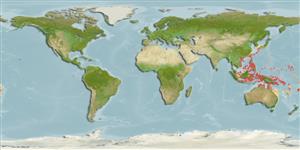>
Gobiiformes (Gobies) >
Gobiidae (Gobies) > Gobiinae
Etymology: Callogobius: Greek, kalos, kallos = beautiful + Latin, gobius = gudgeon (Ref. 45335).
More on authors: McKinney & Lachner.
Environment: milieu / climate zone / rango de profundidad / distribution range
Ecología
marino; salobre asociado a arrecife; rango de profundidad 0 - 10 m (Ref. 37816). Tropical
Western Pacific: Papua New Guinea.
Tamaño / Peso / Age
Madurez: Lm ? range ? - ? cm
Max length : 7.5 cm TL macho / no sexado; (Ref. 90102)
Short description
Claves de identificación | Morfología | Morfometría
Espinas dorsales (total) : 5 - 6; Radios blandos dorsales (total) : 9 - 111; Espinas anales: 1; Radios blandos anales: 7 - 9. Characterized by whitish or tan body color dappled with irregular brown spots and blotches; completely united pelvic fins with well-developed frenum; pointed caudal fin; longitudinal scale series 32-37; predorsal scales absent; head with prominent papillae ridges; absence of cephalic sensory pores; depth of body 4.7-6.0 in SL (Ref. 90102).
Body shape (shape guide): elongated.
Occurs among rubble and coral of weedy or grassy inner reef flats and silty slopes (Ref. 37816).
Life cycle and mating behavior
Madurez | Reproducción | Puesta | Huevos | Fecundidad | Larva
Kailola, P.J., 1991. The fishes of Papua New Guinea: a revised and annotated checklist. Vol. III. Gobiidae to Molidae. Research Bulletin No. 41, Research Section, Dept. of Fisheries and Marine Resources, Papua New Guinea. 153 p. (Ref. 6771)
IUCN Red List Status (Ref. 130435: Version 2025-1)
Threat to humans
Harmless
Human uses
Pesquerías: sin interés
Herramientas
Special reports
Download XML
Fuentes de Internet
Estimates based on models
Preferred temperature (Referencia
123201): 25.8 - 29.3, mean 28.8 °C (based on 1131 cells).
Phylogenetic diversity index (Referencia
82804): PD
50 = 0.5000 [Uniqueness, from 0.5 = low to 2.0 = high].
Bayesian length-weight: a=0.00724 (0.00339 - 0.01546), b=3.10 (2.92 - 3.28), in cm total length, based on LWR estimates for this (Sub)family-body shape (Ref.
93245).
Nivel trófico (Referencia
69278): 3.3 ±0.3 se; based on size and trophs of closest relatives
Resiliencia (Referencia
120179): Alto, población duplicada en un tiempo mínimo inferior a 15 meses (Preliminary K or Fecundity.).
Fishing Vulnerability (Ref.
59153): Low vulnerability (10 of 100).
🛈
